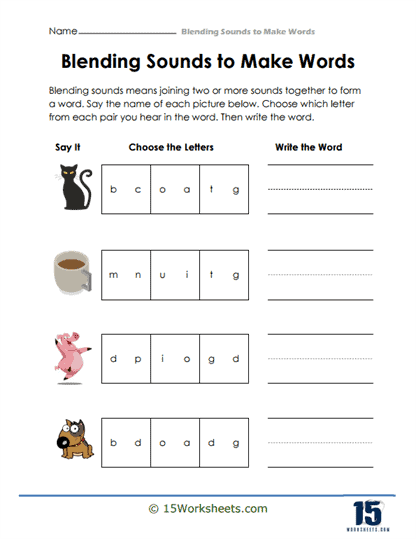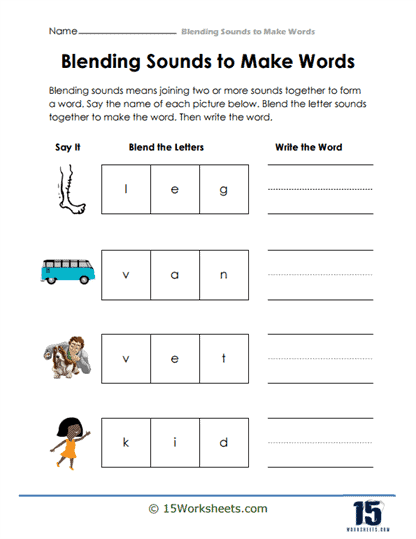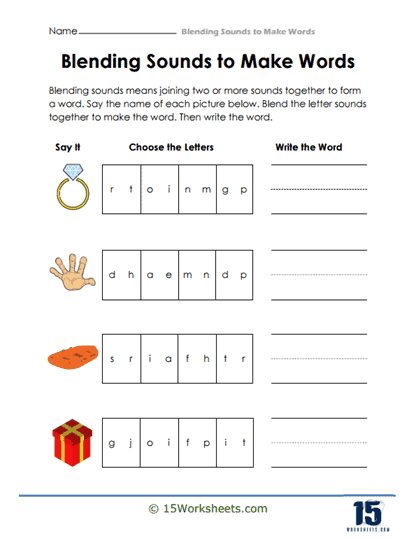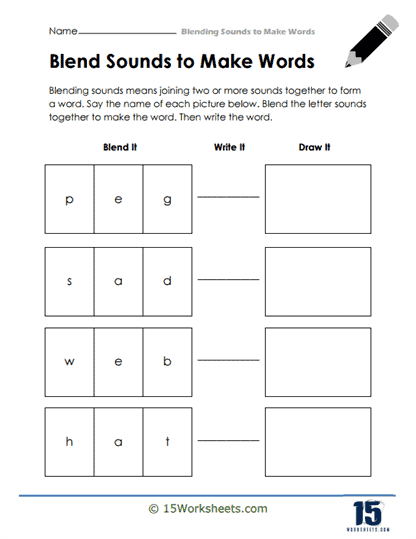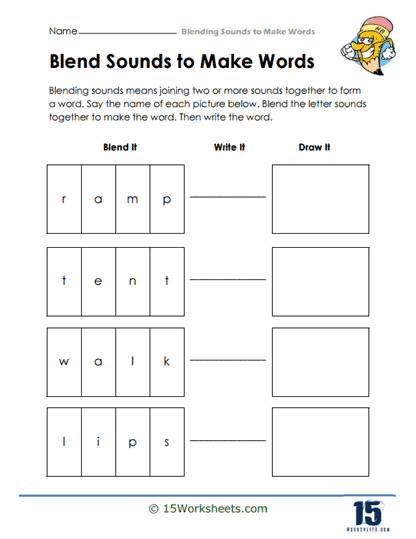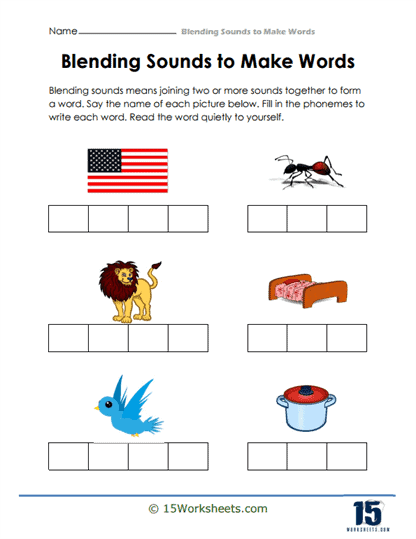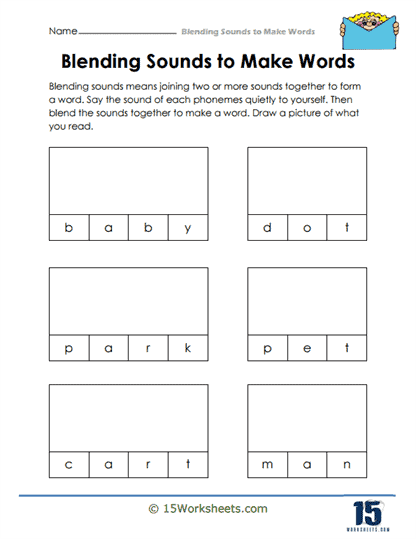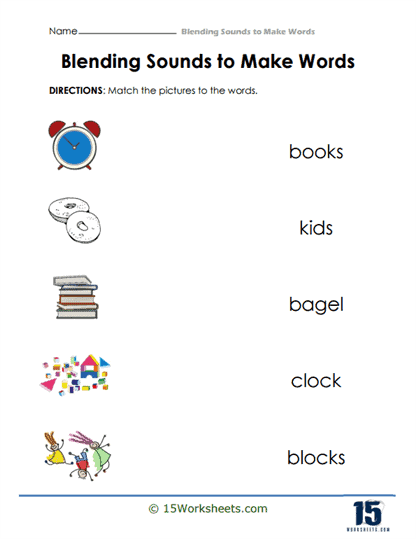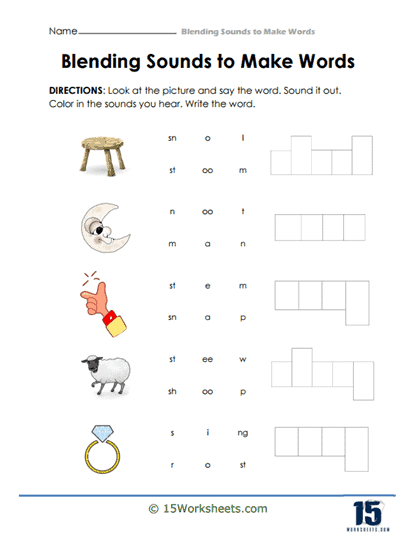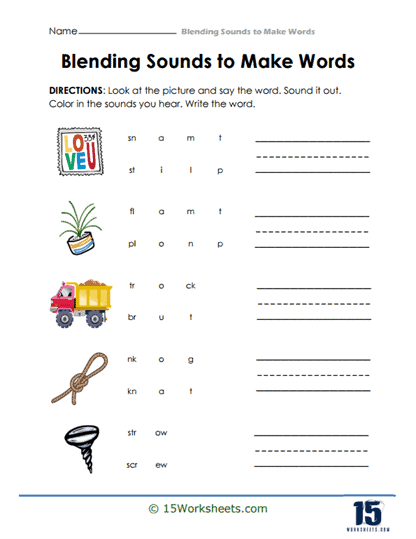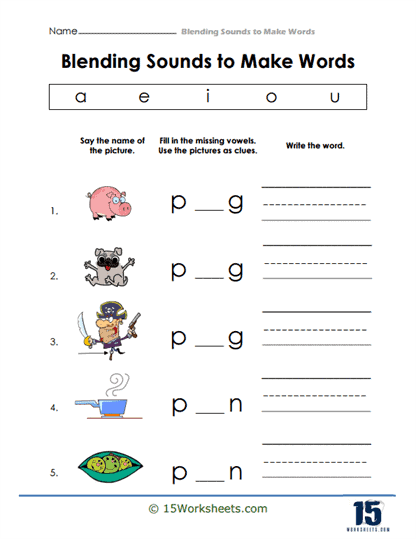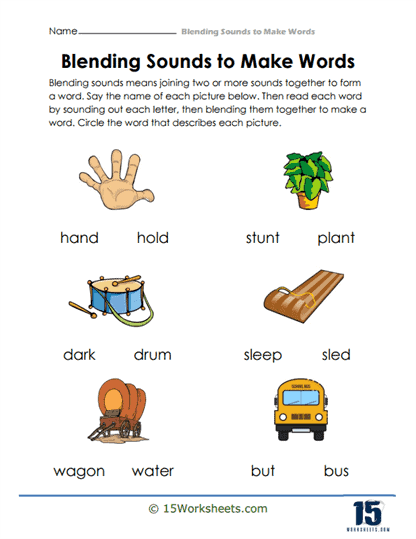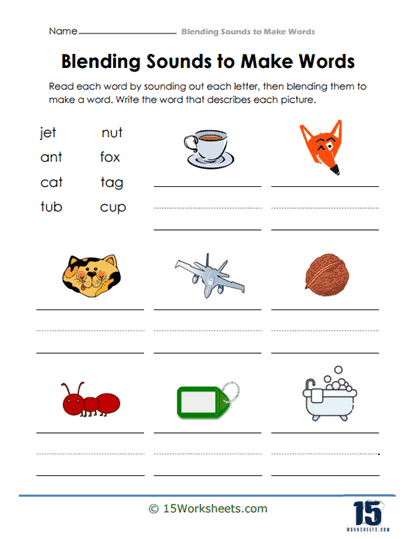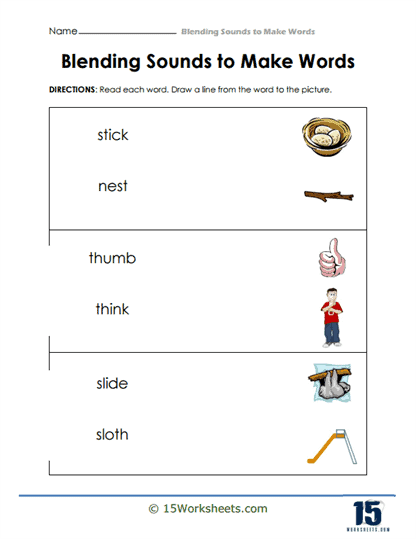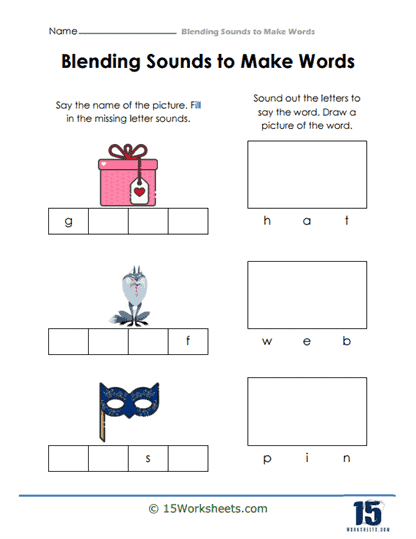Blending Sounds Worksheets
All About These 15 Worksheets
The journey toward literacy begins with a strong foundation in phonemic awareness, and one of the most critical elements of this foundation is the ability to blend sounds. The *Blending Sounds Worksheets* are an essential resource designed to help young students master this skill through engaging, thoughtfully crafted exercises. Phonemic blending-the process of combining individual sounds or phonemes to form words-is a core component of phonics instruction. By using these worksheets, children not only develop the ability to blend sounds but also build the decoding skills that are vital for fluent reading. This comprehensive collection offers a variety of activities that immerse students in practical, hands-on learning, ensuring they can grasp the concept of sound blending in a fun, effective way.
Our Blending Sounds worksheets are specifically designed to teach children how to blend individual phonemes to form words. These worksheets feature activities such as matching sounds, sorting letters, and writing exercises that focus on the sounds of the alphabet and how they come together to create words. For young learners, blending sounds is often a challenge as it requires them to simultaneously recall individual sounds and smoothly connect them into a cohesive word. These worksheets help break down this process into manageable steps, making it easier for children to grasp.
For example, a worksheet may provide a series of pictures representing simple words, like “cat” or “dog,” alongside spaces where students must write the correct letters corresponding to the sounds they hear. By encouraging children to focus on the sounds each letter makes, they practice blending these phonemes into complete words. These activities not only reinforce phonemic awareness but also provide an essential bridge to phonics, where the relationship between sounds and letters becomes clear.
The Importance of Phonemic Blending in Literacy
Blending sounds is a critical part of reading development because it teaches children to decode words-a key step in becoming a fluent reader. Phonemic blending enables students to take separate sounds, such as /c/, /a/, and /t/, and combine them into the word “cat.” By mastering this skill, children can decode unfamiliar words, improving both their reading fluency and comprehension. Without strong blending skills, children may struggle to move from recognizing individual letters to reading words and sentences smoothly, which can hinder their progress in reading.
These worksheets emphasize practice with simple, clear phonemes, which are the building blocks of language. For instance, early worksheets may focus on blending two or three phonemes, such as /s/ and /at/ to form “sat.” As students become more confident, they can move on to worksheets with more complex words and consonant blends, like “clap” or “brush.” Through repeated practice, children develop a mental habit of blending sounds quickly and accurately, a skill that translates directly to their ability to read full sentences with ease.
Engaging Activities for Young Learners
What makes these worksheets particularly effective is the variety of engaging activities they include, which are designed to hold the attention of young learners while teaching crucial skills. Rather than simply asking students to blend sounds, the worksheets turn this task into a game. For instance, one activity may ask children to match a set of pictures to the corresponding blended sounds, allowing them to visually connect the phonemes they hear with the objects they represent. Another worksheet might involve cutting and pasting letters to create words, adding a tactile element that helps reinforce the connection between sounds and letters.
These activities are not only fun but also deeply educational. For example, sorting exercises may challenge students to categorize words based on the initial sound, prompting them to think critically about the beginning phoneme and how it contributes to the overall word. Writing exercises, on the other hand, allow students to practice sounding out words and recording them, reinforcing their ability to connect auditory and visual learning. By presenting blending sounds in diverse, interactive formats, these worksheets ensure that children remain engaged while practicing the skills they need to become fluent readers.
Enhancing Reading Fluency and Comprehension
As students practice blending sounds with these worksheets, they develop reading fluency-the ability to read text accurately, quickly, and with proper expression. Fluency is essential because it allows children to focus on the meaning of what they are reading, rather than expending mental energy on decoding each individual word. Without fluency, reading can become a laborious process, but with these worksheets, students gradually increase their speed and confidence in blending sounds, enabling them to move smoothly from one word to the next.
In addition to improving fluency, blending sounds also enhances reading comprehension. Once students are able to decode words easily, they can focus on understanding the overall context and meaning of a sentence or passage. For instance, a worksheet might introduce a short story where students must blend sounds to form key words in the text. As they read the story, they are not only practicing blending but also using their newly acquired skills to comprehend the narrative. This dual focus on decoding and understanding prepares students for more complex reading tasks as they progress through their education.
Building Confidence in Early Readers
One of the most rewarding aspects of using *Blending Sounds Worksheets* is the boost in confidence that students experience as they improve their phonemic awareness. For many young learners, blending sounds can initially feel intimidating, but as they practice with these worksheets, they begin to see their progress. Completing a worksheet where they successfully blend sounds to form words gives them a sense of accomplishment, reinforcing the idea that reading is something they can master.
For example, a worksheet might start with easier words, like “bat” or “sun,” and gradually increase in difficulty as students gain proficiency. This scaffolded approach ensures that learners are challenged without becoming overwhelmed. As they move through the activities, students gain the confidence to tackle more difficult words, and this confidence spills over into other areas of literacy. Whether reading aloud in class or tackling a new book on their own, students who have practiced with blending worksheets are more likely to approach reading with enthusiasm and determination.
Supporting Phonics Instruction
In a classroom setting, these worksheets serve as an essential complement to broader phonics instruction. Phonics lessons teach students the relationship between letters and sounds, but blending sounds requires practice to fully internalize. Teachers can use these worksheets to reinforce phonics lessons, providing students with the opportunity to apply what they have learned in a structured and engaging way. For instance, after a phonics lesson on the “ch” sound, students could complete a worksheet focused on blending words like “chip” or “chop.” This targeted practice helps students solidify their understanding of specific sounds while also improving their overall blending ability.
The versatility of these worksheets also allows them to be used in a variety of learning contexts. They can serve as homework assignments, in-class exercises, or even group activities where students collaborate to blend sounds and form words. This flexibility makes them an invaluable tool for teachers looking to create a comprehensive literacy program that addresses multiple learning styles and levels of ability.
Whether used at home or in the classroom, these worksheets make the process of learning to read both fun and effective. They not only teach children how to blend sounds but also foster a love of reading by showing them that with practice and persistence, they can unlock the meaning of any word. For students just beginning their literacy journey, mastering phonemic blending with the help of these worksheets opens the door to a lifetime of reading success.
Why Blending Sounds is an Important Skill for Reading
Blending sounds is one of the most crucial skills young readers must develop as they begin their literacy journey. It serves as the foundation for decoding, fluency, and comprehension, ultimately transforming individual letters and sounds into coherent and meaningful language. The process of blending allows learners to connect the dots between what they see and hear, enabling them to read and understand text in a fluid and natural manner. The Blending Sounds Worksheets are designed to support this essential learning process, offering students a structured and engaging way to practice and perfect their blending skills.
Decoding
Decoding is the fundamental ability to translate written text into spoken language by converting letters or letter combinations into their corresponding sounds. This is where blending becomes indispensable. As young learners encounter words, they often need to break them down into smaller components-individual sounds, or phonemes. For example, when presented with the word “cat,” students must first identify the individual phonemes: /k/, /a/, and /t/. Through blending, they learn to combine these sounds smoothly to form the word “cat.” This process is the gateway to understanding written language.
This series offers a wide range of activities that allow students to practice this skill systematically. One exercise might ask students to look at a picture of a familiar object, such as a cat, and then break the word into its component sounds before blending them back together. This not only helps students improve their ability to decode but also makes the process enjoyable by connecting abstract sounds to real-world objects. Over time, students internalize the process of decoding, enabling them to tackle increasingly complex words with confidence.
Phonemic Awareness
Blending sounds also plays a pivotal role in developing phonemic awareness-the ability to identify, isolate, and manipulate individual sounds in spoken words. Phonemic awareness is one of the strongest predictors of future reading success, as it enables learners to recognize sound patterns and apply them to unfamiliar words. When children are able to blend sounds fluently, they are simultaneously strengthening their phonemic awareness, which lays the groundwork for all future reading and spelling tasks.
The worksheets in this collection offer numerous exercises to reinforce phonemic awareness. For example, students might engage in matching activities where they must pair words that start or end with the same sounds, or they may practice segmenting words into their individual phonemes before blending them back together. These exercises help students become more aware of the sounds that make up words, enhancing their ability to decode unfamiliar words in the future. As they progress, students will begin to recognize sound patterns across different words, making reading more intuitive and efficient.
Strengthening Sound-Letter Relationships
Blending is at the heart of phonics instruction, which teaches the relationship between letters and their corresponding sounds. Phonics is the system that helps learners understand that the letters on the page represent the sounds they hear in spoken language. As students practice blending sounds, they are effectively learning how to connect sounds with written symbols-a skill that is essential for accurate and efficient reading.
The worksheets provide ample opportunities for students to strengthen their phonics skills. By engaging in activities that focus on blending, students get repeated practice in linking sounds to the letters that represent them. For example, worksheets might ask students to fill in missing letters in a word after hearing it pronounced, encouraging them to use their knowledge of phonics to spell the word correctly. This kind of targeted practice helps students internalize the sound-letter relationships, making reading easier and more automatic over time.
Reading Fluency
Fluency in reading means being able to read text quickly, accurately, and with proper expression. It is a critical milestone in literacy development because it allows students to read without stumbling over each individual word. Blending sounds is essential for developing this fluency, as it enables learners to process phonemes smoothly and connect them into cohesive words. Once students are proficient at blending sounds, they can read more naturally, allowing them to focus on the meaning of the text rather than getting bogged down by decoding each word.
The worksheets in this collection play a significant role in fostering reading fluency. By providing repetitive practice with a wide variety of words and phoneme combinations, students can improve their speed and accuracy in blending sounds. For instance, worksheets might feature timed reading exercises where students blend sounds to read words or short sentences, helping them increase their reading speed while maintaining accuracy. As students practice and gain fluency, they become more confident readers who can engage with more complex texts.
Comprehension
Blending sounds does more than just help students read individual words; it also plays a critical role in reading comprehension. When students are able to blend sounds efficiently, they can devote more cognitive resources to understanding the meaning of what they are reading. Instead of struggling to decode each word, they can focus on grasping the ideas and information being conveyed by the text. Strong blending skills allow students to move seamlessly from decoding to comprehension, which is the ultimate goal of reading.
This collection supports comprehension by offering exercises that go beyond simple word recognition. For example, students may be asked to read a short sentence or story and then answer questions about its meaning. These worksheets ensure that students are not just blending sounds in isolation but are also applying their skills to real reading tasks that require understanding. By integrating blending practice with comprehension activities, these worksheets help students develop both decoding and higher-level reading skills simultaneously.
Vocabulary Development
Another significant benefit of mastering blending sounds is its impact on vocabulary development. As students become more proficient at blending sounds, they are better equipped to decode unfamiliar words, which can lead to an expansion of their vocabulary. When students encounter a word they have never seen before, their blending skills allow them to sound it out, figure out its pronunciation, and then use context to determine its meaning. This ability to decode new words is crucial for vocabulary growth and overall language development.
For example, a worksheet might introduce students to new words by providing pictures and asking them to blend the sounds to identify the word. This type of activity helps students practice decoding while simultaneously expanding their vocabulary. Over time, as they encounter more complex words in reading passages, they will be able to use their blending skills to independently learn new vocabulary, further enhancing their reading comprehension and language proficiency.

